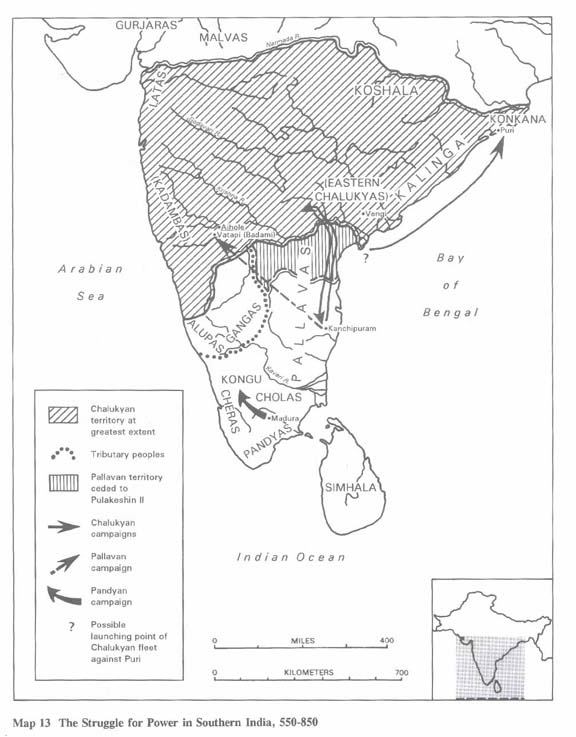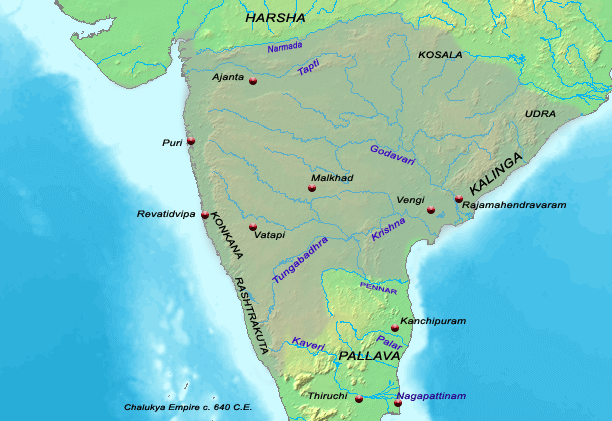Gujjars During :
3.7 Chaulukyas
The Chaulukyas were dominant power in the Deccan during 6th to 8th century AD. And again during 10th century AD, they regained their power and ruled till 12 century. The Chaulukyas who ruled from Badami were the Western Chaulukyas. The one who ruled from Kalyani are referred as Later Western Chaulukyas and the Chaulukyas of Vengi are known to the historians as the Eastern Chaulukyas. The legendary history of the Chaulukyas makes their origin very controversial. But the use of the word GurjarNath and Gurjeshwar by later chaulukya rulers made it very much clear that they were Gurjars by origin. Earlier they were feudatories to Maitrik Gurjars but later claimed independence.

Map 3.3 Map shows the Chaulukya’s Kingdom

Map 3.4 Another map showing Chaulukyas at their peak
Pulakesin-I
With the modest beginning under
Jayasimha and his son
Ranaraga, Chaulukyas ruled
from about 535 to 566 AD. But the real dynasty is known to be founded by
the Maharaja Pulakesin-I.
Pulakesi-I took up many titles such as Satyasraya and was a scholar too.
Though not any conquests are credited to him, he is stated to have ruled
from Badami, the present day Bijapur.
Kritivirman - I
Pulakesin - I was succeeded by his son Kritivirman - I. He constructed
several temples and buildings in the town of Vatapi. The political influence
of Chaulukyas spread over a wider region embracing southern part of
Maharastra,
Mysore
and Tamilnadu. He defeated the rulers of Vanga, Anga, Kalinga, Vattura,
Magadha ....... He is also stated to have broken up the confederacy of
Kadambas.
Mangalesa
Mangalesa, the brother of Kritivirman-I ascended the throne in 598 AD. The
Kalachuris were
conquered by Mangalesa and the whole of central and northern maratha country
was brought into the territory. The eventual civil was between Mangalesa
and his nephew Pulakesi-II cost Mangalesa his own life.
Pulakesi-II
Pulakesi ascended the
throne in 610 AD and ruled till 642 AD. The reign was not a bed of roses for
him, various parts of Chaulukyas assumed independence. The internal
rebellion and the frequent invasion by
Appayika and
Govinda were eventually
subdued. He made Gangas
of south
Mysore
to submit, Mauryas of Konkan were defeated too. These conquests brought him
into contact with Harsha
and in 637 AD Harsha was defeated when Harsha had invaded Kathiawad. He
defeated Pallava king Mahendra Varman -I, and crossed the Cauvery river and
made friends with the Cholas,
Keralas and
Pandyas. Because
Pallavas were not totally
crushed, they took revenge and attacked Pulakesi-II. Pulakesi-II appears to
have been killed in the battle, and the Chaulukya empire began to decline.
Vikramaditya -
I
After the death of Pulakesi-II, Badami and some of the southern districts
remained in the hand of Pallavas. Though Chaulukyas throne remained vacant
from 642 AD - 655 AD, Vikramaditya-I managed to ascend the throne in 655
AD. He recovered Badami and brought the whole kingdom under his control.
Vinayaditya
The next successor Vinayaditya ruled from 681 to 696 AD and carried on
campaigns against Cholas, Pandyas, Pallavas, Aluvas. By defeating the Lord
of the entire Uttarapatha,
he acquired the banner Palidhvaja.
His immediate successor Vijayaditya
ruled for nearly fourty years (696 AD - 733 AD). His reign was stated to
have been peaceful throughout.
Vikramaditya -
II
Vikaramaditya-II was a son of Vijayaditya. He ruled from 734 AD - 745 AD.
He defeated the Pallava king thus putting off the continuing hostilities.
With this conquest, he took possession of musical instruments, banner,
elephants, rubies which belonged to the
Pallavas. He destroyed the
power of the Chola, Kerala, Pandya.
Kritivarman -
II
The son of Vikramaditya-II,
Kritivarman - II succeeded to reign for the next eleven
years. He was the last and glorious ruler of Chaulukyas. For the next
fifty years, the Chaulukya power was totally eclipsed by the
Rashtrakutas.
Dantidurga defeated
Kritivarman-II to gain the control of Chaulukyas once for all. The
subsequent attempt by Kritivarman-II to regain the control was futile. The
Rashtrakutas remained the supreme power for the next two centuries until the
same was destroyed by the later
Western Chaulukyas
of Kalyani.